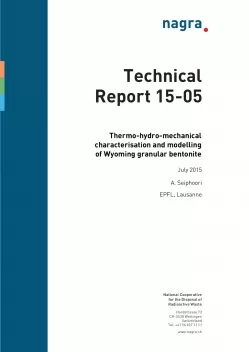
Technical Report NTB 15-05
Thermo-hydro-mechanical characterisation and modelling of Wyoming granular bentonite
Deep geological repositories are considered to be the most suitable solutions for the disposal of high-level radioactive wastes. In several repository concepts, bentonites are selected as the buffer component of the engineered barrier system to be emplaced between the waste canisters and the host rock. The buffer material involved in the confinement of radioactive waste will be submitted to drastic changes of thermal, hydraulic and mechanical conditions. These conditions may significantly influence the behaviour of the buffer material at both the macroscopic and microscopic levels. Safety assessment of the entire repository requires a detailed understanding of the thermo-hydro-mechanical (THM) evolution of the buffer material under such circumstances.
This research contributes to the investigation of the behaviour of bentonite material in an engineered barrier system for the disposal of radioactive waste in Switzerland. It includes comprehensive experimental characterisations of the behaviour of the material under thermo-hydro-mechanical processes with an insight into the microstructural evolutions. The experimental observations on the behavioural features of the material at the macroscopic and microscopic level provide a sound basis for the development of a water retention model to account for the hydro-mechanical coupling and microstructural evolutions. Therefore, the present report addresses the issue from three main perspectives: (i) macroscopic behaviour, (ii) microstructural evolution and (iii) constitutive/modelling directions.
(i) Macroscopic behaviour: a systematic method was used to evaluate the behavioural features of Wyoming granular bentonite under thermo-hydro-mechanical stress paths. After considering a reference grain size distribution, an experimental evaluation of the swelling potential/pressure and the compressibility behaviour of the material was performed. A comprehensive analysis of water retention behaviour was conducted by developing a new technique called the 'Micro-cell' technique, which determines the water retention behaviour with a high resolution by controlling the degree of saturation in the wetting and drying cycles. These initial analyses provided a basis for developing new methodologies for advanced triaxial testing of bentonite materials that experience significant swelling. After developing/calibrating an advanced double-wall triaxial testing system, the thermally-induced strain-stress response of the saturated and unsaturated buffer material and the deviatoric behaviour under a wide range of total suction and confining stresses were evaluated. The effects of the hydraulic gradient and temperature on the hydraulic conductivity of the saturated buffer materials were determined. These experimental activities provided a global picture of the thermo-hydro-mechanical response of the Wyoming granular bentonite under repository-like conditions. The hydro-mechanical response of the granular material influenced by an alternative emplacement technique was assessed within a case study conducted in an underground research laboratory (URL) in Switzerland.
(ii) Microstructural evolution: using the microstructural investigation techniques associated with the 'Micro-cell' device, an insight into the fabric evolution of the bentonite material at different hydraulic states along the water retention domain was obtained. Thus, the change in water retention behaviour was linked to the microstructural modifications. The microstructural analysis demonstrated a clear transition from a double-structured (at the compacted state) to a single-structured porosity network (after full saturation) with permanent features that imposed irreversible behaviour in terms of water retention, resulting in an increase in the retention capacity of the material. Analysis of the available information on the hydration of smectite clay at the particle level indicated the evolution of an active porosity within the microstructure, which consequently affects the macroscopic response of the bentonite. Further investigation of the interaction between the microstructure and water retention characteristics was carried out by analysing the water retention behaviour and microstructural evolution of bentonite and illite materials. This comparison confirmed the existence of an exclusively active (i.e., capillary accessible) porosity within the bentonite microstructure that modified the fabric, particularly when the material approached the full saturation state. The integration of this information from the mutual interaction of the active microstructure and the macroscopic behaviour of bentonite is an important factor in the assessment of the hydro-mechanical response of the buffer material.
(iii) Constitutive/modelling: following the experimental characterisation of granular bentonite, a conceptual water retention model was developed to account for the change in the void ratio and the microstructural evolution during the hydration of the bentonite material. The model was based on an elasto-plasticity approach that used a linear anisotropic hardening rule. The model produced the water retention curves for the entire hydraulic domain under a constant void ratio. The scanning behaviour was analysed at a given compaction state by considering the microstructural void ratio at different saturation stages. The developed formulation of the scanning behaviour could be an essential contribution to the constitutive modelling of high-swelling geomaterials.
